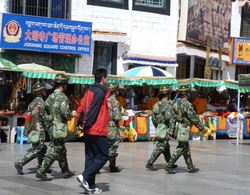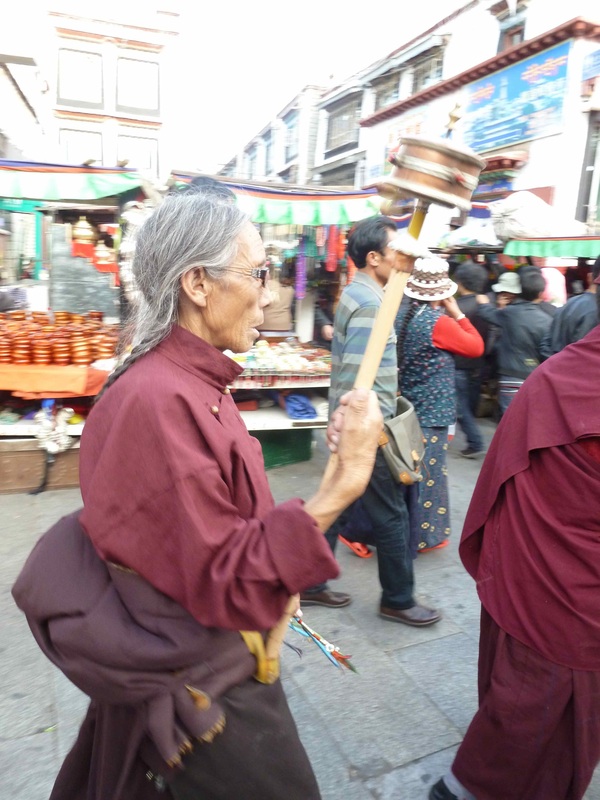Tibetan Buddhism
Tibet was, honestly, a surprise. I had initially factored it in as a logistical hop from China to Nepal, our next stop on the itinerary. I was also intrigued by the idea of taking the “highest train ride in the world” from Chengdu across the permafrost up to Lhasa. However, when we were in Sangri-La in the Yunnan province we met a lot of Tibetans and ate Tibetan food and, let’s just say, we were not overwhelmed. Moreover, given how badly David Evan and I had both been effected by altitude sickness when we hiked up to 5,000 m at Tiger’s Leaping Gorge, we were not looking forward to more heights.
Nevertheless, it was one of our only predetermined stops since the Chinese government requires travelers to book trips through officially sanctioned tour guides before allowing you to venture into Tibet. As soon as we met our guide, Nor Bu, at the train station he took us straight to a rooftop restaurant (apparently well acquainted with travelers suffering from two days of instant noodles while on the train) and within minutes we knew we were not in China anymore. Tibet was the first place we had been so far where people generally kept to their traditional clothing and seemed almost untouched by modern ways.

One of the signs that we were no longer in China was how adults treated our kids. In China, anyone and everyone wanted a photo with the girls and felt no compunction about jumping out with their cameras to ambush them whether they liked it or not. In Tibet, grown ups would light up when they saw the girls and shyly touch their cheeks or reach out hold their hand. Most of the time they did not have a camera themselves so we would end up asking them if we could take a photo. They would get huge grins when we showed them their digital image. By the way, if I walked around without the kids, I was completely ignored, with them I was showered with smiles and invitations to come over and talk!

On that first day, as soon as we looked down on the pilgrims making their way to Jokang Temple, each one dressed in various clothes from different segments of Tibet, we knew we were somewhere special. I’ve never been to any country where religion is such a major factor. It was not only grandmothers and old men praying, inside and outside of every temple we saw teenagers with hipster haircuts and slick sunglasses bowing and making offerings. They were not even towed along behind their family but would come alone with friends and giggle as they ran under the shelves that held the sacred scriptures, something that supposedly confers good karma. Young Tibetans who had given up traditional garb and were decked out in distressed jeans and western shirts were out praying in front of Jokang temple at 7 in the morning on their way to work or school.
The kids had started to learn a bit about Buddhism back in Kuching, Malaysia where we made our first visit to a Chinese temple. They became devoted pyromaniacs, begging to light incense and “lucky money” at every possible opportunity. But Chinese buddhism is so bound up in fortune telling that they were more interested in the I Ching sticks and rock tossing that believers used to solve their life questions at the altar.

Tibetan Buddhism is a whole ‘nother kettle of fish. The air around the temples palpably thrums with worship. Mothers carry their babies on their back as they circumnavigate the building in an endless circle, stylish young ladies slip off their high heels as they unroll their prayer mat to prostrate themselves in front of the walls, too-cool-for-school teenage boys solemnly bless themselves as they pour butter into the sacred lamps and everywhere monks chant, drum or simply sit and meditate. We learned about Tibetan Buddhism not just by visiting the temples and monasteries and seeing the statues and paintings and hearing the stories they depict, although we did learn alot from Nor Bu, but mostly by seeing their faith in action. In every street, there was somebody spinning a prayer wheel or buying sweet smelling grass to burn in a corner urn for offerings. When we stopped to watch a group of villagers harvest their barley crop, we were invited in for tea and found a beautiful altar inside the house. This is not a world where religion is separate from daily activity. Our guide taught his baby daughter the chants to say in the morning when she woke up “because this is what makes us different from animals, we are human beings”. Prayer is as natural as breathing here.

Right at the center of Lhasa is Jokang Temple - the holiest temple in the holiest town in the holiest country for Buddhism. Inside the temple is a statue of buddha said to have been created while the real buddha was alive and so is one of the only relics said to have been touched and blessed by the buddha himself. Pilgrims from the farthest reaches of Tibet have traveled here just to see it, some literally on their hands and knees as they prostrated themselves mile after mile along the highway on their way here. The Chinese government will only allow Tibetans to enter in the morning and by 6 am there is already a long line of families waiting to go in.

We wait till the afternoon to give them their space and once inside realize that the Chinese do not allow monks to wear their robes inside this space. They are only allowed to be caretakers, not perform any rituals or ceremonies except on one or two special days of the year. None the less, the experience is very moving. We are not allowed to take photos inside and the Tibetans are evidently not allowed to full length bow either but there is a full crush of Buddhists carrying thermos of melted butter to top up the butter lamps in front of every shrine. When we came outside there were just as many people praying outside the walls as before we went in.
Before arriving in Tibet I was worried it would be boring for the kids just to go to monastery after monastery but they seemed to enjoy it and certainly learned all the high points of Siddartha’s life. At the Sera monastery Monks give special blessings to children by putting soot on their noses which left them with panda faces for a day. This monastery is also known as the home of the "fighting monks" because each day the monks congregate in the garden to "vigorously" debate the finer points of Buddhist scripture. To make a point, the speaker lunges, slaps his hands and lashes his meditation beads like a whip.

One cannot help but remember that in Tibet, to be a monk is to be a warrior. We later visited Deprung Monastery which is the equivalent of Harvard as the most esteemed college of Tibet. It used to house 7,000 monks but is now allowed only 300, its number being capped by the Chinese government. This monastery was completely shut down in 2008 after their monks led a protest against Chinese oppression which turned violent. That is, the monks were shot and killed as they marched. The government says only 22 were killed in the riots but Tibetan sources put the figure much higher. Looking at the faces of the young monks, you couldn’t help wondering how many just like them had been killed or imprisoned.

We heard stories of how during the cultural revolution monks had been stripped of their robes, their sacred instruments crushed and scriptures burned in front of them. How many survived is an unanswered question. Even though China is now pouring in money to repair shrines and monasteries torn apart by their own soldiers in an effort to attract tourists they still have tight control over who and how visits occur. The Potola Palace and the Dalai Lama’s Summer Palace are contbe seen as historical museums not religious pilgrimage sites. Each Tibetan family house is required to fly the Chinese flag and keep posters of Mao and the current leaders of China inside. It is impossible to say what it is like for Tibetans to live under the constant presence soldiers toting machine guns. On the surface they seem to go blithely about their business, serenely ignoring the soldiers. But then on the other hand, this year so far, eight young monks and one nun have set themselves on fire to bring world attention to the oppression of Tibe

I never visited the USSR under heavy communism and by the time I visited Beijing six years ago China was already well on their way to their version of capitalism. But here you can feel the heavy hand of government surveillance and repression. Maybe the Tibetan people's buddhism seems so vigorous and strong because they have to push so hard to retain it. We can only admire them and hope they are able to maintain their separate culture despite the constant influx of Han Chinese.




